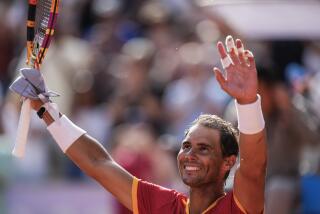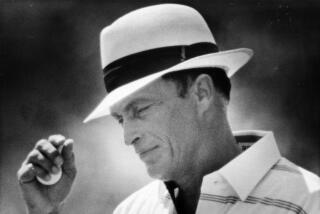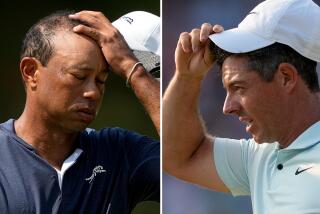Tiger Opens Up, Jack Shuts Down
- Share via
ST. ANDREWS, Scotland — Ivor Robson, the starter at the British Open, never offers a comment when he introduces the players on the first tee.
Robson simply announces who’s up next in a sing-song tone. But when the 8:50 a.m. group’s turn came Friday, Robson’s voice hit a couple of extra-high notes when he said a certain name.
“On the tee, Jack Nicklaus.”
Robson smiled and the warm applause came down from the grandstand and spilled over from across the fairway. Perhaps he took a little extra enjoyment in saying it one more time, for what very well could be the last time.
Nicklaus knows better than to say never, but he realizes he doesn’t care to keep coming back simply to take victory laps around the old links courses and leave before Saturday.
That’s the state of his game now, after he finished his two rounds (77-73) at six over and missed the cut.
“I won’t say no, but I certainly am not going to play unless I can be competitive,” Nicklaus said. “I don’t just want to take up a spot.”
The burning desire that drives certain people to the top of their sport never flickers out. The drive to be the best will be there for the rest of Nicklaus’ life, even if it means playing miniature golf.
But now he can’t reconcile his desire with his inability to execute.
It was evident when he described the problems he has been having with his putting earlier this week: “I’ve been almost able to will the ball in the hole through most of my life. When I wanted to make a putt, I’d figure out how to get it in the hole. And my will is not as strong as it used to be, I guess.”
The will isn’t the problem.
There’s nothing wrong with his head at all. His mind is sharp enough that he can still remember the yardage and club selection for shots he hit in 1964.
Only his muscle memory has slipped. His brain can recall the proper motions, it’s simply that the arms, legs and that artificial hip can’t execute them anymore. It’s as if something gets lost in the translation.
He drove the green on the 357-yard 18th hole in 1970. On Friday his drive barely made it past Granny Clark’s Wynd, the road that crosses the fairway 238 yards from the tee. He also missed a six-foot putt that could have given him a nice going-away birdie.
Nicklaus made occasional pauses for sentiment during his round. He waved his cap to the adoring crowds on every hole. He paused while crossing the Swilcan Bridge on the 18th hole and posed for pictures, then asked his son (and caddie) Steve to join him.
But in Nicklaus’ mind, this was all two days too early.
When a radio interviewer inquired about the walk up the 18th fairway to thunderous applause by asking, “How great an experience was that,” Nicklaus responded: “Missing the cut?”
During a moment between television interviews, Nicklaus turned to his wife Barbara, who was standing a few feet away. Not much sweet talk in that conversation, either.
“Bogey, bogey, bogey, bogey,” Jack said.
(After 40 years of marriage, she should be used to such focus on the sport. He played golf on their wedding day, and on three days during their honeymoon.)
Meanwhile, Robson grabbed the microphone.
“On the tee, Tiger Woods.”
The past, present and future were within 50 feet of each other.
Even more likely than Woods’ predicted path of greatness, that he will eventually near and perhaps surpass Nicklaus’ record of 18 major championships, is the inevitability that one day he will be just like Nicklaus is now.
At the moment, however, Woods is a lot like Nicklaus was back then.
“He has a good head on his shoulders,” Nicklaus said. “It’s very easy to have a good head on your shoulders when you don’t worry about making anything from 15 feet in. . . .
“I didn’t worry too much about chipping because I never missed anything inside 15 feet anyway.
“There were periods of time when I was doing exactly what he was doing. Nothing matters, because I’m going to knock it in anyway. When you get that, boy, the game becomes easy.”
Woods has risen to the top and left the rest of the field behind so quickly that he already is being asked where he finds motivation.
Woods said his sole mission is to keep improving and become the best player he can be, even if that means he never wins another tournament. But clearly, players of that caliber need some outside challenge, even if they have to manufacture them.
“His goals are probably to beat my goals,” Nicklaus said.
But what kept Nicklaus going even after he passed the old record of 13 majors?
“I liked to play,” Nicklaus said. “I enjoyed the challenges of each guy that came along. Every time, whenever, Arnold [Palmer] first, and Gary [Player], and then all of a sudden Tom Weiskopf came along, [Tom] Watson came along, [Lee] Trevino came along and [Johnny] Miller and always there was a somebody that came along that posed a challenge. And I always enjoyed that.
“Tiger hasn’t had that yet, but he will. He hasn’t really had any challenges.”
It was supposed to be David Duval, then Sergio Garcia. Neither has been up to the task. Ernie Els has demonstrated this year that he can push Tiger, but he might end up being nothing more than a pace car, left behind after the opening lap.
Nicklaus pointed out that he had to face guys who had won six, seven or eight majors, who really knew what to do when they played on the big Sundays.
He suggested that the person to challenge Woods might be watching him on television right now.
Woods, the man who might challenge Nicklaus in the record books, was 11 years away from being born when Nicklaus first came to St. Andrews in 1964.
“It seems like a long time ago,” Nicklaus said. “Years just pass. You don’t think about it.”
Then one day you’re 60, talking about the Next Thing, remembering what it was like when that person was you.
*
J.A. Adande can be reached at his e-mail address: [email protected].
(BEGIN TEXT OF INFOBOX / INFOGRAPHIC)
Nicklaus in British Open
A look at Jack Nicklaus in the British Open. In bold type are British Opens at St. Andrews:
1962: T34
1963: 3
1964: 2
1965: T12
1966: 1
1967: 2
1968: T2
1969: T6
1970: 1
1971: T5
1972: 2
1973: 4
1974: 3
1975: T3
1976: T2
1977: 2
1978: 1
1979: T2
1980: T4
1981: T4
1982: T16
1983: 2
1984: T25
1985: T32
1986: T16
1987: T24
1988: miss cut
1989: T30
1990: T63
1991: T44
1992: miss cut
1993: miss cut
1994: miss cut
1995: T79
1996: T45
1997: T60
1998: didn’t play
1999: didn’t play
2000: miss cut
More to Read
Go beyond the scoreboard
Get the latest on L.A.'s teams in the daily Sports Report newsletter.
You may occasionally receive promotional content from the Los Angeles Times.










